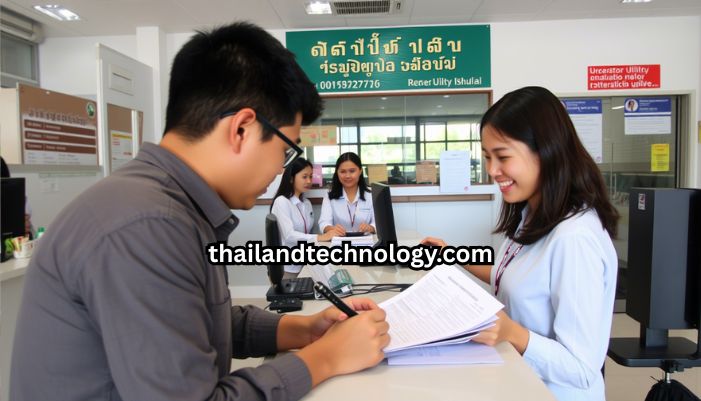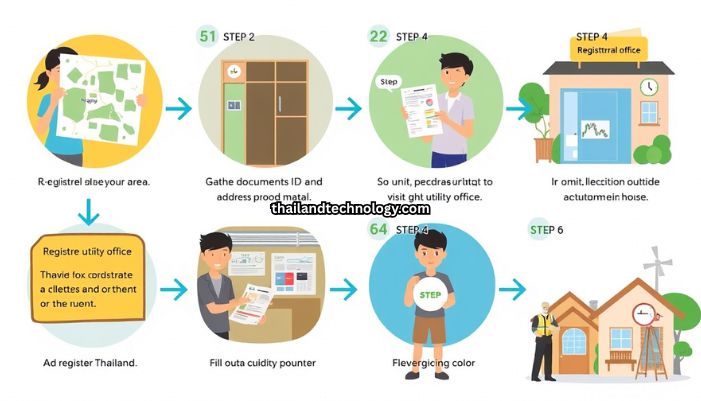If you’ve just moved to a new place in Thailand, or you’re setting up a new home or business, you’ll need to register for your electricity bills. It may sound tricky, but don’t worry! The process is easier than it seems. Whether you’re a local or a foreigner living in Thailand, this guide will walk you through every step, so you can turn on the lights and stay worry-free.
Let’s break it down in a clear, simple way.
What Is Electricity Bill Registration in Thailand?
In Thailand, everyone who uses electricity needs to register with one of two main providers:
- MEA – Metropolitan Electricity Authority: for Bangkok, Nonthaburi, and Samut Prakan.
- PEA – Provincial Electricity Authority: for everywhere else in Thailand.
When you move into a new place, you can’t just use power right away. First, you must register your name with the right office. After that, you’ll get a meter installed (if there isn’t one already), and you’ll start receiving monthly bills.

Why You Need to Register for Electricity
Electricity isn’t free—and if your name isn’t on the bill, you might face trouble later. Here’s why registration is important:
- Avoid service cuts: If no one pays the bill, power will be shut off.
- Proof of residence: Your electricity bill can be used as address proof for banks or government offices.
- Control your usage: When you’re registered, you can track and manage your electricity use better.
Step-by-Step: How to Register for Electricity Bills
Step 1: Know Your Area
First, figure out if your home or property is under MEA or PEA.
- Living in Bangkok, Nonthaburi, or Samut Prakan? → You’re with MEA.
- Anywhere else in Thailand? → You’re with PEA.
Go to their website or call to make sure.
Robots Dot to Dot Nattapong: Fun, Art and Robots 2025
Step 2: Collect the Right Documents
Before visiting the office, prepare these items:
If you’re renting or living in a house:
- Your Thai ID or passport
- A rental contract or house deed
- House Registration Book (Tabien Baan) if you’re Thai
- Consent letter from the property owner (if you’re renting)

If you’re a business:
- Business registration certificate
- Owner’s ID or passport
- A signed power of attorney (if someone else is registering)
Tip: Make photocopies. Offices usually keep them.
Step 3: Visit the Nearest Office
Go to your local MEA or PEA office. If you’re not sure where it is, search online or ask neighbors.
Some areas let you register online, but walking in is often easier and faster—especially if it’s your first time.
Step 4: Fill Out the Registration Form
At the office, you’ll get a form to fill out. Don’t worry—it’s short and simple. Staff will help you if you’re unsure.
Details asked might include:
- Your full name
- Property address
- Contact number
- Meter details (if already installed)
Step 5: Submit and Pay the Deposit
Once your form and papers are ready, hand them over. You might need to pay a security deposit, which depends on your meter type.
- Small homes: around 500–2,000 THB
- Businesses: varies by size and usage
You’ll get a receipt. Keep this safe.
Step 6: Get Your Electricity Meter Installed
If there’s no meter yet, the office will send a technician to install one. This can take 1–7 days, depending on your area.
If there’s already a meter, you’ll get connected fast—sometimes even on the same day.
After Registration: What Happens Next?
Once you’re registered, you’ll begin receiving electricity bills monthly.
You can:
- Pay online (via apps, banks, or websites)
- Pay in person (at 7-Eleven, banks, or the electricity office)
Keep an eye on the due date. Paying late might lead to power cuts or extra fees.
Online Registration Options
Some parts of Thailand allow online registration through MEA and PEA websites.
- PEA Smart Plus App: Register, pay, and monitor usage.
- MEA Smart Life App: Available for MEA customers.
These apps make it easy to view your bill, track usage, and report problems.
Tips to Make It Easier
Here are some helpful tips to keep things simple:
- Take photos of your documents and save them on your phone.
- ✅ Always bring both originals and copies.
- Visit offices in the morning to avoid long lines.
- If you don’t speak Thai, bring a Thai friend or ask staff for help—they’re usually kind and willing.
Common Problems and Easy Fixes
Problem: My name isn’t on the bill.
Ask the current bill holder to transfer it to your name. You’ll both need to visit the office.
Problem: I lost my bill.
Use the MEA or PEA app to download it or go to the office for a copy.
Problem: The power is off!
First, check if you forgot to pay. If yes, pay right away and show proof. If not, call the office to report the outage.
Frequently Asked Questions (FAQs)
Conclusion
Registering for electricity in Thailand might feel confusing at first, but it’s really just a few simple steps. Bring the right documents, visit the correct office, and ask for help if needed. Once you’re set up, you’ll enjoy hassle-free service—and you’ll never have to worry about missing a bill.
So whether you’re new to Thailand or just moving to a new place, follow this guide to get your electricity running smoothly.











